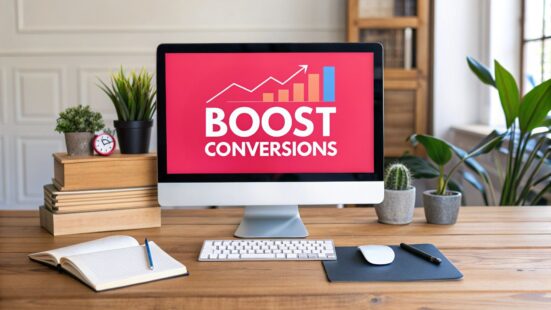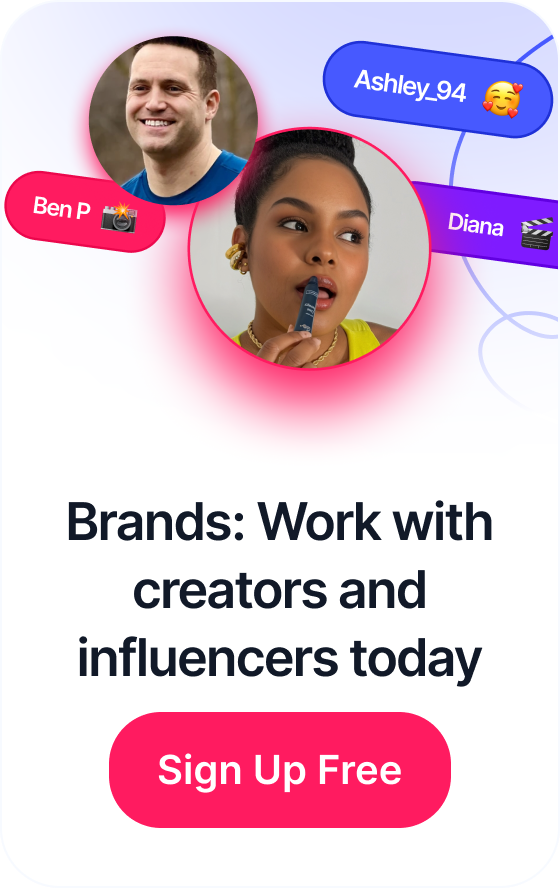 How to Boost Online Sales Fast
How to Boost Online Sales Fast
Affiliate marketing conversion rates are one of the most important metrics you can track.In a nutshell, it’s the percentage of people who click your affiliate link and then actually do the thing you want them to do—usually, make a purchase. This number can swing wildly, typically landing somewhere between 0.5% and 10% depending on your industry and how you're promoting the product.
Table of Contents
Decoding Affiliate Marketing Conversion Rates

Think of it this way. Imagine you’re a helpful employee in a store. You get a commission, but only when someone buys a product you personally recommended. Your conversion rate is simply the scorecard showing how often your recommendations actually lead to a sale.
It's the ultimate measure of your effectiveness. Clicks are nice, but they don't pay the bills. Conversions do. This single number tells you how healthy—and profitable—your affiliate partnerships really are.
Calculating Your Success
The formula itself is incredibly simple, but don't let that fool you. It's a powerful way to turn a list of clicks into real, actionable insight. This is the language that tells you if your hard work is resonating with your audience and making money for your partners.
(Total Conversions / Total Clicks) x 100 = Conversion Rate
So, if your affiliate link got 1,000 clicks and those clicks resulted in 20 sales, your conversion rate would be 2%. That quick calculation is the bedrock of performance analysis for any affiliate campaign.
Why This Metric Matters So Much
Your conversion rate is more than just a number on a dashboard. It’s a direct reflection of how well you understand your audience and the products you’re promoting. If you want to brush up on the fundamentals, check out our guide on what is affiliate marketing.
A high rate is a great sign—it means your content and the offer are perfectly aligned. On the flip side, a low rate is a red flag that something is disconnected.
Keeping a close eye on this key performance indicator helps you:
- Spot your top-performing content so you can do more of what works.
- Optimize campaigns that are falling flat by figuring out what's wrong.
- Negotiate better commission rates with merchants by showing them the value you bring.
Looking at recent global data gives us a solid benchmark. As of June 2025, the average affiliate marketing conversion rate across all industries hovers around 1.20%. This number often tracks high-intent actions like signing up for a free trial or requesting a demo—things that signal a qualified lead. To see more on these industry-wide trends, TotalProductMarketing.com has some great insights.
What’s a Good Affiliate Conversion Rate? (Hint: It Depends)
Trying to set goals for your affiliate conversion rates without any context is like running a race with no finish line. You're just running blind. You absolutely need benchmarks to get a feel for what's possible and, more importantly, what's realistic for your specific corner of the market.
Let's be clear: a "good" conversion rate isn't some magic universal number. It changes wildly from one industry to the next.
Think about it. A lifestyle blogger pushing a $20 makeup palette is going to see a much higher conversion rate than an affiliate selling a $2,0__00 business software package. The buying decision is worlds apart. The makeup is an easy impulse buy, while the software involves research, budget approvals, and a way longer sales cycle.
Niche Performance Varies Widely
This massive variation is just part of the game in affiliate marketing. Different niches have completely different playing fields and, therefore, completely different average conversion rates.
Some of the big affiliate networks report an average conversion rate of around 5%, but top-tier affiliates can easily push that to 10% or even higher, especially in super-engaged niches like health and wellness. On the flip side, you'll see rates closer to 1.8% for financial products. Fashion and apparel often land somewhere in the middle, averaging around 6%. You can find more great data on these network stats over at wecantrack.com.
This image gives you a great visual on how the averages stack up against the top-performing niches.

What's the big takeaway here? Even though the overall average seems modest, there's a huge ceiling for affiliates who pick the right niche and really dial in their strategies.
To give you a clearer picture, let's break down some typical conversion rates across popular affiliate sectors.
Average Affiliate Conversion Rates by Niche
This table offers a snapshot of how conversion rates can differ from one industry to another. It's not about finding the "best" niche, but understanding the unique performance landscape of each.
| Niche / Industry | Average Conversion Rate |
|---|---|
| Health & Wellness | 7% – 12% |
| Dating & Relationships | 5% – 10% |
| Software & SaaS | 4% – 8% |
| Fashion & Apparel | 4% – 6% |
| Finance & Investing | 2% – 5% |
| Travel | 2% – 4% |
| Electronics | 1% – 3% |
As you can see, what's considered "average" in one vertical might be outstanding in another. This is why comparing your electronics blog's numbers to a wellness influencer's is a recipe for frustration.
Key Factors Behind the Numbers
Knowing why these numbers are so different is the key to setting goals you can actually hit. Don't get discouraged by comparing your stats to a totally unrelated industry. Instead, dig into the dynamics of your own turf.
So, what's driving these differences? A few key things:
- Product Price Point: Cheaper stuff just converts more easily. There's less financial risk for the buyer, so it's an easier "yes."
- Sales Cycle Length: High-ticket items or B2B services require a lot of thought. People don't drop thousands of dollars on a whim, which naturally leads to lower immediate conversion rates.
- Consumer Trust: Niches like beauty and wellness thrive on personal trust. An authentic recommendation from an influencer someone follows and trusts can be incredibly powerful and drive high conversions.
- Commission Structure: The action you're asking for matters. A pay-per-lead or pay-per-signup offer will almost always have a higher conversion rate than a pay-per-sale model because the user's commitment is much smaller.
Key Factors That Influence Conversion Success

Seeing industry benchmarks is a good starting point, but if you really want to move the needle on your own affiliate marketing conversion rates, you have to look under the hood of your own strategy. Think of your affiliate funnel as a chain—it only takes one weak link to break the whole thing.
Success here isn't about luck. It’s the result of several key pieces working together perfectly. To figure out what’s working and what’s not, we need to break down the four pillars that every high-converting affiliate campaign is built on. By digging into each one, you can stop guessing and start making targeted changes that actually boost your income.
Audience and Product Alignment
This is the big one. If the product you’re promoting isn’t a perfect match for your audience, nothing else matters. This kind of mismatch is the number one reason affiliates see tons of clicks but almost no sales. You can write the most compelling review on the planet, but if you're trying to sell steaks to a room full of vegetarians, you're going home empty-handed.
Let's say you run a popular blog for budget backpackers. Promoting an all-inclusive luxury resort is just a bad fit. Sure, some readers might click out of curiosity, but the offer doesn't solve their actual problem or fit their wallet. Real alignment happens when the product you recommend feels like the most natural, obvious solution to a problem your audience is already trying to solve.
A high conversion rate is the ultimate proof that you've correctly identified your audience's needs and presented them with the ideal solution. It’s less about selling and more about targeted problem-solving.
Content Quality and Trust
Your content is the bridge that connects your audience's problem to the product's solution. If that bridge looks flimsy or untrustworthy, nobody’s going to cross it. Thin, low-effort articles stuffed with affiliate links just scream "sales pitch," and your visitors will click away in a heartbeat.
On the flip side, high-quality, genuinely helpful content builds authority and makes people trust your recommendations. This is where you prove you know your stuff.
- In-depth Reviews: Don’t just list the features. Share your real experience using the product, show it in action, and be honest about the good and the bad.
- Helpful Tutorials: Create guides that walk people through using the product to get a specific result. This gives them immediate value and positions the product as a tool for their success.
- Comparison Posts: Write fair, data-driven comparisons between a few different products. This shows you’re an unbiased expert helping them make the smartest choice, not just any choice.
Landing Page Experience
Once someone clicks your affiliate link, your part of the job is mostly done, but the conversion journey is far from over. The merchant's landing page has a massive say in whether that click actually turns into cash. A slow, confusing, or sketchy-looking landing page can kill a sale in seconds, even if the lead was super interested.
Think of it like a relay race. You just ran a perfect leg, handing off a warmed-up, qualified lead. The merchant’s landing page is the next runner. If they trip—because the page loads like molasses, the checkout is a nightmare, or the messaging feels completely different from your content—your team loses the race. Always, always click through and test the entire user journey yourself before you commit to promoting an offer.
Offer Competitiveness
Last but not least, the deal itself has to be good. Is the price fair? Is there an exclusive discount or a special bonus for using your link? In a busy market, a competitive offer is often the final push someone needs to pull out their credit card.
This is a secret weapon for many top affiliates. They work directly with brands to negotiate special deals just for their audience. This adds real, exclusive value and turns a simple recommendation into an opportunity people can't get anywhere else.
How Top Affiliates Achieve Higher Conversions
When you look at what separates the average affiliate from the top earners, you start to see a pattern. It’s not about secret tricks or loopholes. The truth is much simpler: high-earning affiliates have a system built on audience trust and delivering overwhelming value. This is how they consistently blow past the typical affiliate marketing conversion rates.
While most affiliates hover around a 1% to 3% conversion rate, the ones who truly master their craft often see numbers in the 5% to 10% range. Some influencers with incredibly dedicated followings can even push conversions between 4% and 8% just by leveraging their hard-won credibility. You can see a deeper dive into these affiliate conversion statistics on wecantrack.com. This gap isn’t a fluke; it's the direct result of a smart, deliberate strategy.
Building a Foundation of Trust
At the heart of every high-converting affiliate strategy is one thing: trust. Before anyone clicks your link and buys something, they have to buy into you. The best way to do this is to stop thinking about "promoting a product" and start thinking about "solving a problem" for a specific group of people.
Top affiliates become the go-to resource in their niche. They don't just parachute in with affiliate links. They build an entire library of valuable content that serves their audience’s needs first, always.
Success in affiliate marketing isn't about having the largest audience, but the most engaged one. A smaller, loyal community that trusts your recommendations will always outperform a vast, indifferent crowd.
By consistently showing up with genuine help and advice, these affiliates build a rock-solid reputation for authenticity. So, when they finally do recommend a product, it doesn't feel like a sales pitch. It feels like a natural, helpful suggestion from a trusted source.
Developing High-Value, Conversion-Focused Content
Trust gets your audience to listen, but it’s high-quality content that convinces them to act. The pros create content that anticipates and answers every possible question a potential buyer might have. We're talking way beyond a simple shout-out.
Instead, they focus on creating things like:
- In-Depth Product Reviews: Not just a spec sheet, but a detailed walkthrough showing the product solving a real-world problem. Think original photos, custom videos, and honest pros and cons.
- Detailed Comparison Guides: Unbiased, side-by-side comparisons that help people make an informed choice. This positions the affiliate as an impartial expert, not just a salesperson.
- Tutorials and How-To Guides: Content that shows the product in action. This helps users visualize themselves getting a specific result, proving the product's value before they even spend a dime.
This approach allows affiliate links to be woven in naturally, as helpful resources rather than jarring ads. Of course, this requires working with quality brands, which is why selecting offers from the best affiliate marketing platforms is such a crucial first step. At the end of the day, their content serves the reader above all else—and that’s precisely why it converts so well.
Proven Strategies to Boost Your Affiliate Conversions

Knowing what drives your affiliate marketing conversion rates is one thing. Actually improving them is where the real growth happens. The good news? You don’t need a huge budget or a suite of complicated tools to see a difference. Often, it’s the small, strategic tweaks that lead to the biggest jumps in your affiliate income.
Think of this as your playbook for making an immediate impact. By focusing on proven tactics that tap into marketing psychology, you can start turning more of those clicks into commissions. Let's get into the actionable strategies you can roll out today to lift your performance and maximize what you earn.
Optimize Your Calls to Action
Your call-to-action (CTA) is the most critical piece of the conversion puzzle. It’s the final nudge you give your reader, and a weak one can bring a motivated buyer to a screeching halt. Fine-tuning your CTAs is often the single highest-impact change you can make.
You need to think beyond a lazy "Click Here." Your CTA copy has to be specific, build a little urgency, and scream value. Instead of a generic command, try framing it as a clear benefit for the user.
- Weak CTA: "Buy Now"
- Strong CTA: "Get 50% Off Your First Order Today"
See the difference? That small shift turns a demand into an exciting opportunity. Don't be afraid to test different button colors, either—bright, contrasting colors like orange or green almost always grab more attention than muted ones. Play around with placement, too, and see what works best for your audience.
Create Compelling Bonus Offers
In a crowded niche, a killer bonus can be the ultimate tie-breaker. Why should someone buy through your link over the dozens of others out there? An exclusive bonus gives them a powerful reason and instantly jacks up the perceived value of what you’re offering.
The best bonuses are hyper-relevant to the main product and solve the next problem the buyer will have.
Why It Works: This approach taps directly into the principle of reciprocity. When you offer extra value upfront, people feel like they’re getting an incredible deal. It encourages them to buy through your link so they can claim their exclusive reward.
For example, if you’re promoting project management software, you could throw in a free bonus bundle of pre-made project templates. This adds real, tangible value that they can't get anywhere else, making your affiliate link the obvious choice.
Use Comparison Tables to Simplify Decisions
When potential buyers are trying to choose between a few options, they’re often drowning in information. A clean, well-designed comparison table cuts right through that noise. It presents the most important details in a format that’s incredibly easy to scan and understand, positioning you as the helpful expert guiding them to the right decision.
Your table should clearly lay out the key features, pricing, and unique selling points of a few products, with an emphasis on the one you recommend. Use simple visual cues like checkmarks or bolded text to make your preferred option's advantages pop. It's a fact that 90% of consumers are on the lookout for discounts, and a comparison table is the perfect spot to highlight any special offers.
Implement Simple Retargeting Campaigns
Did you know that, on average, a staggering 70% of online shopping carts are abandoned? That means a lot of the people clicking your affiliate links are interested but just aren't ready to pull the trigger at that moment. Retargeting is your secret weapon to bring them back.
By placing a simple retargeting pixel (from platforms like Facebook or Google) on your review pages, you can show targeted ads to people who have already signaled their interest by clicking your link. These ads can serve as a gentle reminder of the product's benefits or even tempt them with a limited-time discount to create a little urgency. Sometimes, that simple follow-up is all it takes to close the deal and secure the commission.
Measuring and Tracking Your Conversion Performance
If you're not measuring, you're guessing. Flying blind in affiliate marketing means leaving money on the table, plain and simple. To really dial in your affiliate marketing conversion rates, you need a solid tracking system that tells you exactly what’s working and what’s falling flat.
This all starts with your affiliate links. Moving beyond generic, one-size-fits-all links is the first step toward making smart, data-driven decisions. It’s about getting granular so you can see the complete picture of your performance.
Pinpointing Your Top Performers with Sub-IDs
The single most powerful tool for this is the Sub-ID, sometimes called a tracking parameter. Think of a Sub-ID as a unique nametag you attach to each affiliate link. This little tag lets you identify precisely where every single conversion came from.
For instance, you could create unique links for:
- Different blog posts (e.g.,
&subid=product-review-2025) - Email newsletter campaigns (e.g.,
&subid=email-blast-june) - Specific calls-to-action on a single page (e.g.,
&subid=comparison-table-cta)
When you do this, your affiliate dashboard transforms from a list of anonymous sales into a detailed performance report. You can instantly see that your in-depth product review is driving 80% of your sales, while that banner ad you thought was great is getting clicks but zero conversions. That kind of insight is pure gold.
Without tracking parameters, every click and conversion is a mystery. With them, you become a detective, uncovering clues that lead directly to higher profits and a more effective strategy.
Interpreting Your Affiliate Data
Once you have this detailed data flowing in, the next step is to make sense of it. Log into your affiliate network's dashboard and look beyond vanity metrics like total clicks. Clicks don't pay the bills—conversions do. Your focus should be on the numbers that directly impact your bottom line.
Then, pair these insights with data from Google Analytics. While your affiliate dashboard shows you the final conversion, Google Analytics reveals what users were doing before the click. Are visitors from a certain social media campaign bouncing immediately? Is one of your pages keeping readers hooked for minutes at a time? This helps you piece together the entire user journey.
It's also super important to understand how different touchpoints contribute to a sale. Digging into what is attribution modeling can give you a much clearer picture of which channels truly deserve the credit. And don't stop at affiliate metrics; understanding the key website metrics to track for growth will provide a more holistic view of your site's health. This combined approach is how you systematically optimize your strategy for maximum revenue.
Frequently Asked Questions
When you start digging into affiliate marketing conversion rates, a few common questions always seem to pop up. Let's tackle them head-on to clear up any confusion and get you on the right track.
What Is a Good Affiliate Marketing Conversion Rate
This is the million-dollar question, and the honest answer is: it completely depends on your niche. There’s no magic number that works for everyone.
The industry-wide average hovers around 1.2%, but that figure can be pretty misleading. For example, if you’re in a high-volume niche like fashion, hitting a 6% conversion rate is fantastic. But if you’re promoting complex, big-ticket B2B software, a 2% rate might be absolutely stellar.
The best thing you can do is stop chasing a universal number. Instead, figure out your own baseline performance. From there, your only goal is to consistently improve it through smart testing and optimization. A "good" rate for you is one that's always trending up.
How Can I Track Conversions from Different Blog Posts
The secret here is using Sub-IDs, sometimes called tracking parameters, in your affiliate links. Pretty much every affiliate network out there lets you add a unique identifier to your standard link.
It's as simple as adding something like &subid=in-depth-review to the end of your URL. This little tag tells your affiliate dashboard exactly which piece of content—which blog post, email, or social media update—sent the sale. By giving each campaign its own Sub-ID, you can finally see which strategies are actually making you money and which are just spinning their wheels.
Why Are My Clicks High but Conversions Low
Ah, the classic "lots of clicks, no cash" problem. This almost always points to a breakdown somewhere in the user journey after they leave your site. High click volume means your content did its job—you got people interested. Low conversions mean something is stopping them from sealing the deal.
Usually, one of these culprits is to blame:
- Audience Mismatch: Your content is drawing in curious browsers, but they aren't the right fit for the product you're promoting.
- Expectation Gap: Your review or article promised one thing, but the merchant's landing page didn't deliver on that promise.
- Poor Landing Page Experience: The page they land on is confusing, loads too slowly, or has a checkout process that’s a total headache.
Ready to connect with a network of over 250,000 creators and amplify your brand's reach? JoinBrands provides the tools to manage influencer campaigns, generate authentic UGC, and drive sales seamlessly. Start your first campaign today on JoinBrands.








